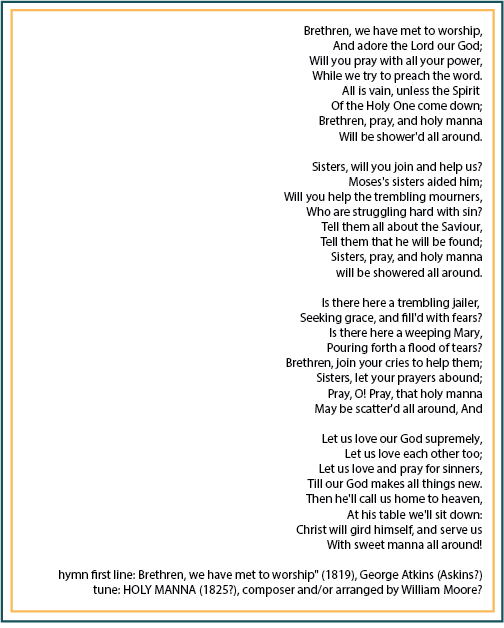repertoire
PART III
looking forward
The Clear Title
arr. C. Leonard Raybon
Two of SH’s tunes for this text (DUDLEY and THE SAINTS’ DELIGHT) are used for this arrangement. A recurring “I’ll bid farewell” motive acts as connective tissue for this sometimes rousing, sometimes subdued piece. Do you know the “ten thousand years” verse that is missing from the last verse of “Amazing Grace” in SH? Well, it shows up as the last verse here!
Manna All Around
arr. C. Leonard Raybon
This is the hymn that started the Sacred Nine Project. Fast, rhythmic sections flank a slow, meditative verse to carry this message of Christian community.
The Other Side of Jordan
arr. C. Leonard Raybon
Imagine shape-note singers from the early nineteenth century from neighboring towns who get together and sing. They always end their sessions with “On Jordan’s Stormy Banks.” The traditional tune in one village is THE PROMISED LAND and in the other, JORDAN’S SHORE, and they love to improvise a kind of antebellum mash-up, where one member from each group calls the respective tunes. At first the tunes are pretty well-contained, but by the end, each melody start to overlap more and more, adding to the camaraderie. The triplet theme employed in the introduction and interlude is inspired by the way David Lee, a noteworthy leader in the Sacred Harp community, leads tunes, as found in the link below.
David Lee, prominent figure in Sacred Harp singing, leads CLEANSING FOUNTAIN. My arrangement of "The Other Side of Jordan" is inspired by the his way of sing-counting at 1'30''. Sacred Harp singing at Mount Pisgah Primitive Baptist Church. May 22 , 2010
Here is David Lee again, leading one of the tunes for this arrangement, The PROMISED LAND. Sacred Harp singing at Mount Pisgah Primitive Baptist Church. 5/23/15 David Lee leading.
Tedious and Tasteless
arr. C. Leonard Raybon
John Newton, author of “Amazing Grace,” spins out exquisite verse here. In the last verse, the Sacred Nine Singers become a bluegrass band. The basses are the upright basses, the tenors and altos are rhythm guitars, and the sopranos are the fiddles.
All three categories: REGRET, REPENT, REJOICE
The Conversion of Captain Kidd
arr. C. Leonard Raybon
This is the furthest departure from the usual formula for the Sacred Nine Project pieces. Instead of having this piece represent one hymn, it represents three. Why? I thought it was curious that such a strange meter got so much “real estate” in SH. At least three hymns employed different tunes with this unique meter, perhaps originating from an English folksong about Captain Kidd.
SOLEMN THOUGHT (one of Walker’s favorite tunes), WONDROUS LOVE, and CAPTAIN KIDD work in succession to exemplify all three Sacred Nine categories of Regret, Repent, and Rejoice.
The French Broad
arr. C. Leonard Raybon
FRENCH BROAD was one of the first tunes William Walker’s mother taught him, and it remained dear to him. The imagery in the arrangement is that "Tenor the Sinner" at the beginning is being lured into a life of sin by the successive voices that pile on for each verse. The turning point is the central, solfege verse, which puts the tenor back on the right track home. The palindromic layout for the verses suggests the journey away from, and back to Christ. The arrangement is a homage to Bach’s Jesu, meine Freude, in which Bach perhaps uses the same structure to remind us of the Prodigal’s journey from and to the Savior.
Christian Harmony 208b FRENCH BROAD


















